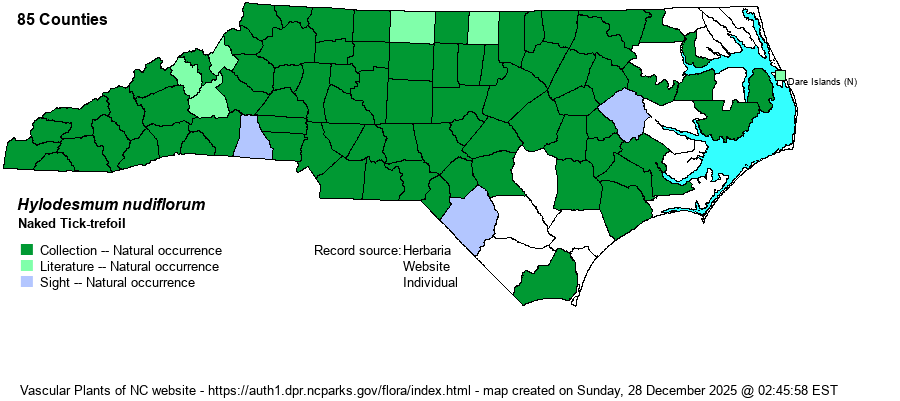| Author | (L.) H. Ohashi & R.R. Mill | |
| Distribution | Occurs statewide, but of spotty occurrence in the lower Coastal Plain. Still, it might occur in all 100 counties.
This is a widespread species across the eastern states. It ranges from eastern Canada south to the FL Panhandle and eastern TX. | |
| Abundance | Common and widespread across the Mountains, Piedmont, and the northern 2/3 of the Coastal Plain, but scarce toward the coast, where uncommon and perhaps local. | |
| Habitat | This is a forest-based tick-trefoil (formerly in the genus Desmodium). It occurs in a great variety of forests, from fairly dry to mesic to rich, but it is not normally found in bottomlands or other floodplain forests. It is one of the more frequently seen herbs of Mesic Mixed Hardwood Forests and various Oak-Hickory Forest types. |
| Phenology | Blooms in July and August, and fruits from August to October. | |
| Identification | This is a somewhat unique herbaceous plant in growth form. It has two stem types: one is the vegetative stem, which grows to about 6-12 inches long, with about 4-7 large leaves (each with 3 leaflets) growing from a single node (whorl) at the top of the otherwise "naked" stem. The leaf petiole is several inches long, and the leaflets average about 2 inches long and are mostly ovate in shape with a fairly acute tip. The leaflets are not distinctly different from many other tick-trefoils, but the fact that there is a separate stem bearing only the flowers is unique. This flower stalk is rather "wand-like", often leaning, and reaches about 2-2.5 inches long. There is a panicle of pink flowers at the top, each flower about 1/4-inch across. Even without the flowering stalk present, this species (and H. glutinosum) are the only plants with a whorl of trifoliate leaves at the top of a naked stem, but the latter is rare east of the mountains and it has a distinctly top-shaped terminal leaflet that is concave on the sides near the acuminate tip. This should be an easily found herbaceous species on your forest walks in somewhat mesic forests, typically on slopes; in fact, in the "dog days" of summer, in July and August, it might be one of only a few species you will see in bloom in the shade of the forest. The tall leaning stem with numerous small pink flowers is bound to attract attention. | |
| Taxonomic Comments | Formerly included, along with Hylodesmum glutinosum and H. pauciflorum, in the genus Desmodium. Some references, including NatureServe, still retain it in Desmodium.
| |
| Other Common Name(s) | Nakedflower Tick-trefoil, Naked-flowered Tick-trefoil. References are about evenly split between the use of just "Naked" versus "Naked-flower" (and variants of this name). Technically, the flowers are not "naked"; the implication is that there is a separate flowering stalk with no leaves (i.e., is naked), separate from the sterile stalk with leaves. | |
| State Rank | S5 | |
| Global Rank | G5 | |
| State Status | | |
| US Status | | |
| USACE-agcp | | |
| USACE-emp | | |

